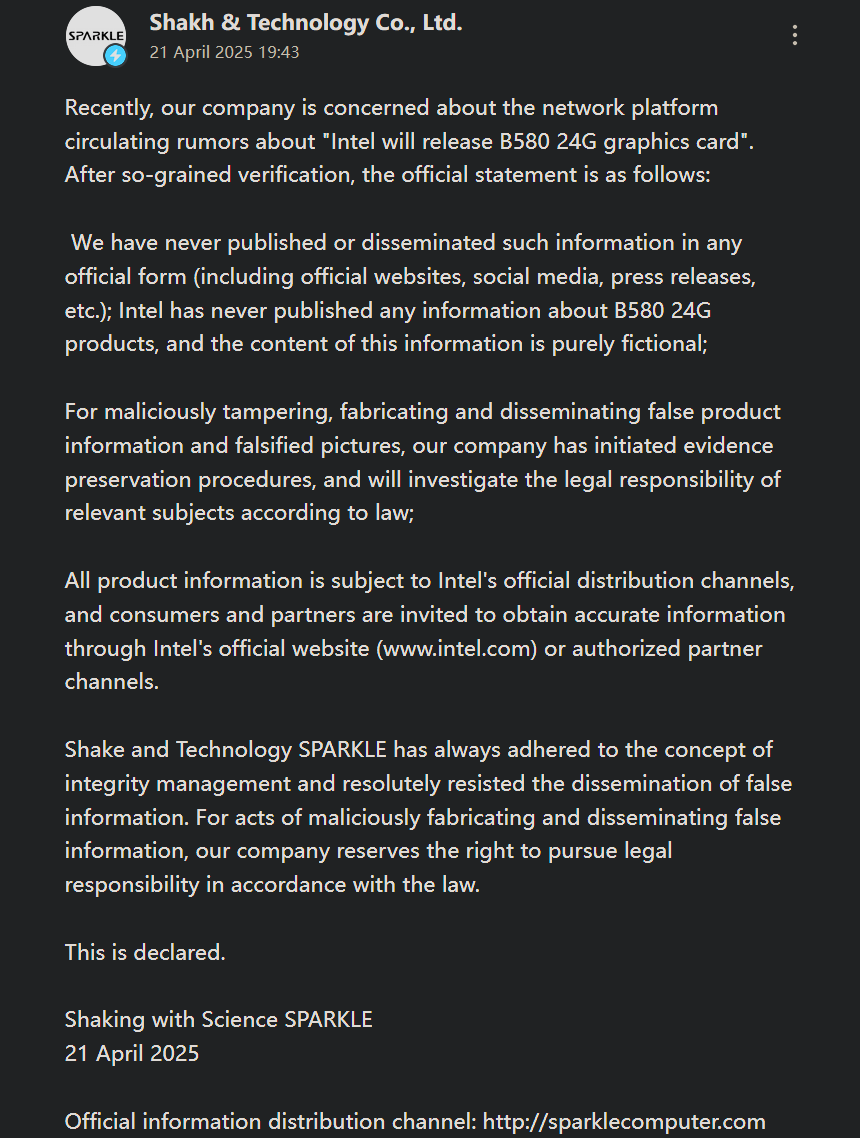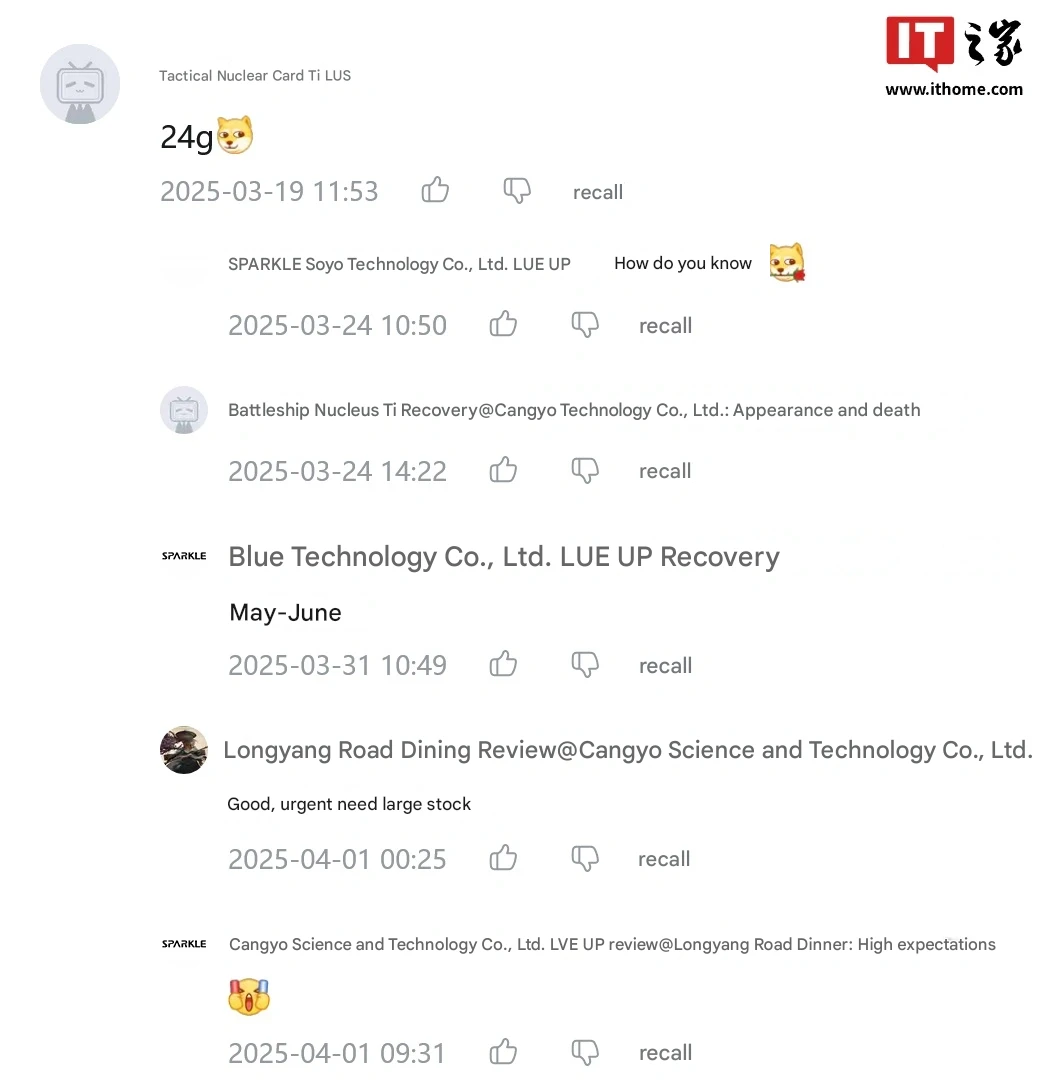Rumors swirl about a 24GB Intel Arc B580 — but OEM swiftly strikes down claims
It's still possible the GPU exists

The GPU rumor mill has been spinning like crazy this morning. The whole thing kicked off when Sparkle's Bilibili account supposedly confirmed the existence of a 24GB variant of the Intel Arc B580 (via ITHome). A media manager also alluded to a potential release window between May and June. But this was short-lived as Sparkle has officially retracted these comments. Perhaps this is a move to manage fallout after a potential NDA breach? It's hard to say for certain, but this isn't the first time we've heard of a 24GB spinoff of Battlemage.
Intel officially introduced its Arc Battlemage GPU lineup in December of last year. From this family, the Intel Arc B570 and Arc B580 were crafted using the mid-range BMG-G21 die, featuring a 192-bit interface for six memory channels. Shipping documents have suggested the existence of alternate BMG-G31 and BMG-G10 variants, likely for the B700 and B300 families, but Intel has not made any official confirmation yet.
This slip-up seemingly corroborates existing rumor, positioning this GPU under Intel's Arc Pro family, succeeding existing Alchemist-based Flex or Pro-series options, for AI applications. From what we can gather, Intel is allegedly deploying the BMG-G21 die, the same as the B580, with 24GB of memory configured using 12x 16Gb modules in clamshell mode. That's a twofold increase in memory capacity over Intel's current Arc Pro A60 offering.
Architecturally speaking, Battlemage is one generation behind Nvidia and AMD. For tasks demanding raw compute muscle, this Arc B580 24GB, or whatever Intel ends up naming it, will probably not land blows against Nvidia's Blackwell PRO or AMD's upcoming Radeon PRO W9000 GPUs. These can, however, compete in AI training and inference, which necessitate a lot of VRAM in cases like Large Language Models (LLMs), and image/video generation models like Stable Diffusion.
The economics don't favor Intel if they were to create a higher-end GPU. At similar die sizes, Intel's PPA (Performance Per Area) and architectural shortcomings become apparent: the B580 at 272mm2 (using N5) is priced at $249, while Nvidia sells its RTX 5070, which uses a 263mm2 die (using N4P) at $549. While N4P wafers might be pricier than N5 (likely not double), that's still a small consideration.
Either way, Sparkle's seeming confirmation, followed by a swift retraction, suggests there's potentially more beneath the surface. If this GPU does exist, we can expect to hear more from Intel at Computex, where we might also get an early look at Panther Lake, similar to how Lunar Lake was unveiled last year.
Stay On the Cutting Edge: Get the Tom's Hardware Newsletter
Get Tom's Hardware's best news and in-depth reviews, straight to your inbox.

Hassam Nasir is a die-hard hardware enthusiast with years of experience as a tech editor and writer, focusing on detailed CPU comparisons and general hardware news. When he’s not working, you’ll find him bending tubes for his ever-evolving custom water-loop gaming rig or benchmarking the latest CPUs and GPUs just for fun.
-
TheyStoppedit 24GB is pointless on a card that probably wont be any faster than a 5060Ti, at best.Reply -
usertests Reply
It's not unheard of for a professional card. For example:TheyStoppedit said:24GB is pointless on a card that probably wont be any faster than a 5060Ti, at best.
RTX 2000 Ada Generation is slower than the RTX 3060 and has 16 GB
RTX 4000 SFF Ada Generation is slower than the RTX 3060 Ti and has 20 GB
These are similar to the 4060 and 4070 respectively, but limited to 70 Watts. -
Notton From what I could find online, Davinci Resolve is the only app that runs out of 12GB of VRAM.Reply
The B580 seems to offer a mixed bag of performance in said app, which hovers between a 4060 and 4070.
On a similar, but different rumor mill, the Arc B770 is showing up in shipping manifests.
There is absolutely zero talk of a B380/B350/B310 when A3xx series stock is non-existant.
It's a shame because Arc A3xx was the only cheap way to add AV1 encode/decode on an AM4 X3D machine. -
ejolson I agree 24GB will not help game performance.Reply
From my point of view, Intel needs a path of entry into the AI market. An economically priced GPU with 24GB of memory may provide enough of an incentive for people to tune interference software for Intel hardware.
After the software ecosystem reaches the point where inference is running well, then selling more profitable datacenter GPUs designed for AI training becomes a possibility.


